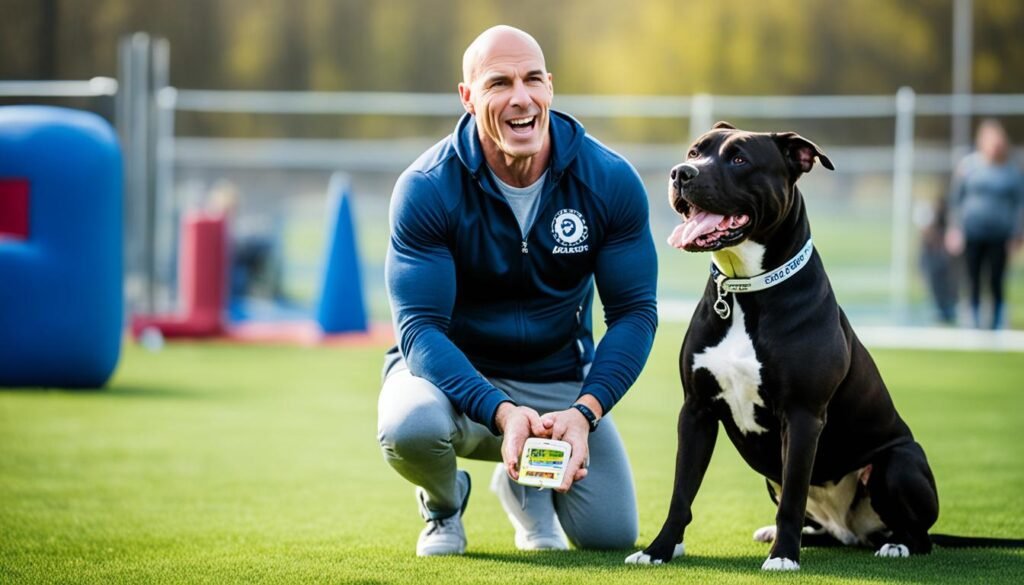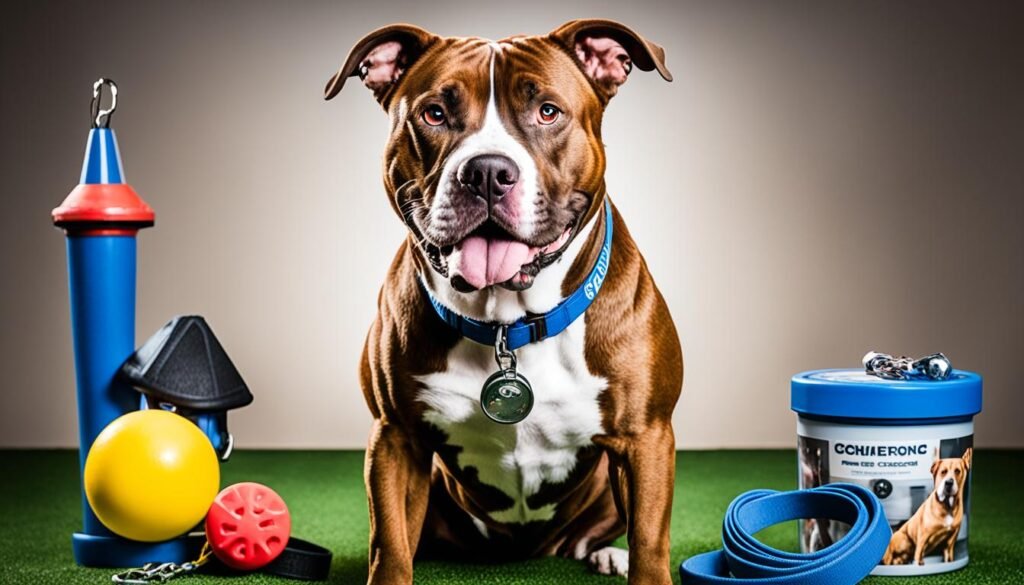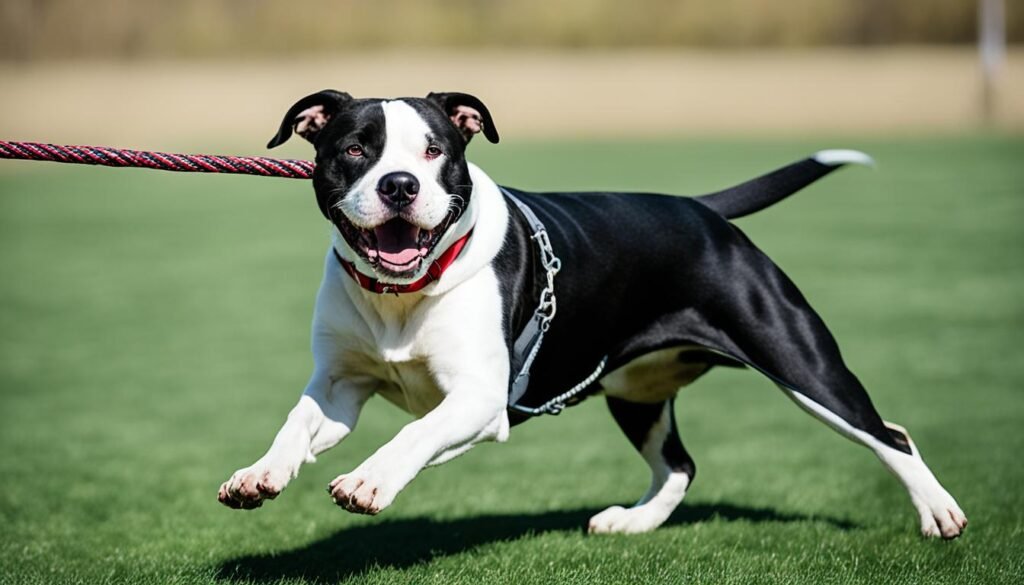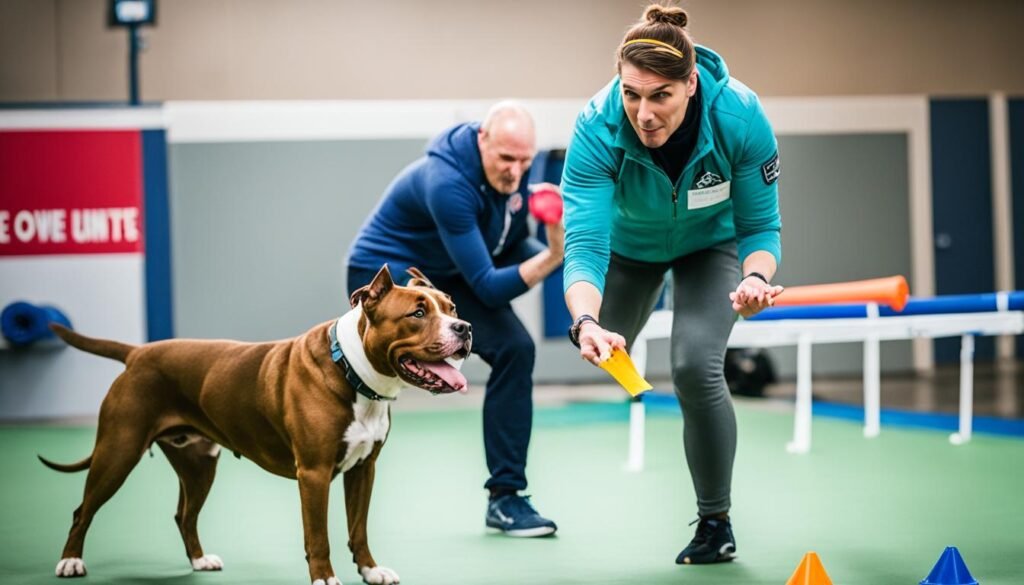Physical Address
304 North Cardinal St.
Dorchester Center, MA 02124
Physical Address
304 North Cardinal St.
Dorchester Center, MA 02124
Training your pitbull is key to a well-behaved and obedient dog. I’ll share proven training techniques. They’ll help you bond with your pitbull and make training positive for you both. These tips work well for both novices and experienced dog owners.
Training a pitbull takes time, consistency, and the right methods. With these tips, you can turn your pitbull into a polite and well-trained friend.

To have a well-behaved pitbull, you need to follow key training methods. We’ll cover three main areas: obedience, crate, and leash training.
Obedience training sets the groundwork for a responsive pitbull. It’s about teaching them basic commands like sit, stay, and come. Masters these, and your pitbull will be better behaved and quick to respond to you.
Consistency is crucial for teaching obedience. Keep training sessions short but regular. Use treats, praise, and petting to keep your pitbull interested and learning happily.
Using a crate is great for housebreaking your pitbull and giving them a safe spot. Make the crate appealing by adding treats and toys. This helps them see it as a cozy place of their own.
Start slow with crate training. Welcome your pitbull to the crate by making it fun. Once they’re comfortable, reward them for going in and staying calmly. Stick to this, and they’ll learn to love their crate.
Leash training is a must for pitbulls to walk nicely and safely. At the start, let them get familiar with the leash and collar. Give treats when they walk well without pulling.
Clear and consistent instructions are key in leash training. Gradually extend walk times and lengths. This will help your pitbull stay calm and polite even in busy areas.
These training methods are essential for your pitbull’s good behavior. Always be positive, consistent, and patient in your training. This will lead to a well-adjusted pitbull.
To train a Pitbull successfully, specific tips are needed. These tips will help you build a strong bond with your dog. They also ensure the best results in training. Let’s look at three essential tips:
Positive reinforcement works wonders for training your Pitbull. It means rewarding good behaviors rather than punishing bad ones. You can do this with treats, praising words, or showing affection. This positive approach helps your Pitbull understand what’s right. It encourages them to keep doing good things.
Being consistent is key when training your Pitbull. This means using the same commands and applying rules all the time. Whether it’s about staying off furniture or not begging for food, the rules should never change. Such consistency teaches your Pitbull what’s expected. It speeds up their learning process.
Training your Pitbull will take time, so you need to be patient. Every dog is different, and they learn at their own pace. It’s okay if some skills are harder to learn. Stay positive and calm during training. Celebrate the small achievements. Building a strong bond with your Pitbull requires time and patience.
Applying positive reinforcement, being consistent, and having patience are vital. They’ll help your Pitbull learn and grow with you. By following these tips, you and your dog will enjoy a positive training experience. This leads to a strong, lasting relationship.

Are you new to pitbull training? This guide is all you need. Trust is key, and I’ll show you how to build it. You’ll also learn the vital commands every pitbull should know. Socializing your dog is a must, and we’ll dive deep into it. Welcome to your starting guide on pitbull training.
Start by building trust with your pitbull. Quality time is a big part of this. Walk, play, and groom together. Use treats and praise for good behavior. Always be patient and avoid being harsh or using punishment.
Teaching basic commands is a must for clear communication. Begin with “sit,” “stay,” “down,” and “come.” Use positive reinforcement and be consistent. Take training step by step and be patient with your pitbull.
For a well-behaved pitbull, socialization is vital. Introduce them to people, animals, and new places early. Set up doggy meetups and visit parks. Use rewards for good social behavior. A well-socialized dog is a happy, confident dog.
Aggression can be a tough issue with pitbulls. Knowing why your pitbull is aggressive is key. It helps in training them well, keeping them and others safe. Here, I’ll share tips on handling aggression and making your home peaceful.
First, let’s get why pitbulls might get aggressive. They could be scared, protecting their stuff, marking their territory, or not know how to act with others. Figuring out what’s causing their aggression is the first step.

Using positive ways to train is most effective for aggressive pitbulls. This means praising and rewarding good behavior to encourage it. If your pitbull is calm and not aggressive, reward them. This method can reduce their aggression in the long run.
If aggression doesn’t improve, a pro may be needed. A professional who knows about aggressive pitbulls can make a personalized plan. This expert advice is crucial for dealing with your pitbull’s aggression.
| Pitbull Aggression Training Tips | Description |
|---|---|
| Identify Triggers | Figure out what sets off your pitbull. Knowing this helps tailor a training plan. |
| Desensitization and Counterconditioning | Exposing your pitbull to what triggers them slowly, and in a good way, changes their response. Positive experiences help them deal better. |
| Establish Boundaries | Make rules to stop aggressive acts early. Being clear and consistent matters a lot. |
| Avoid Punishment | Punishment only makes things worse. It can lead to more fear and aggression. |
| Redirecting Focus | Teach them positive things to do instead of being aggressive. This can stop bad behavior. |
| Provide Mental and Physical Stimulation | Keep your pitbull busy and happy to avoid aggression. They need both mental and physical activities. |
| Consistency and Patience | Sticking to your plan and being patient are crucial. It’s a long process to see change. |
Using these tips and getting help when you need it can make a huge difference. You can help your pitbull be less aggressive, making your home safer for everyone.
Obedience is key in training a pitbull, enhancing the bond with your pet. In this guide, we’ll look at crucial commands to teach your pitbull. Every pitbull needs to know these commands to be well-behaved, quick in response, and polite in all situations.
Start by teaching your pitbull to sit. This command is great for controlling energetic behaviors like jumping and encouraging calmness. To teach “sit,” use positive methods like treats and praise when they follow your command.
The stay command is important too. It tells your pitbull to hold a position until they can move. Begin with asking them to sit or lay down. Then, use voice and hand signals to say “stay.” Reward them and make the stay time longer as they learn.
Teaching your pitbull come is essential for safety. Start indoors with little distractions. Use happy sounds and positive training to draw them to you. Add more distance and distractions over time to strengthen this command.
Learning the down command helps your pitbull stay calm in various situations. It’s good for when guests come over or during mealtimes. Use a mix of words and actions to get them to lie down, rewarding good efforts with treats and praise.
Another crucial command is leave it. It helps your pitbull avoid things they shouldn’t touch. Begin with something of low interest on the floor. Tell them to “leave it.” Use more tempting items and distractions as they get better at this command.
Being consistent and patient is very important when training your pitbull. Use positive reinforcement always. With regular practice, your pitbull will learn to be a polite and obedient friend.

Socializing a pitbull is key to making them friendly and well-rounded. It’s best to start when they’re still a puppy. This lays a strong base for their behavior and helps them become used to different places and people. We’ll look into some great ways to socialize pitbulls, like taking them to various places and using rewards to teach them.
Early Socialization: Starting early is always best. Make sure your puppy meets many different people, animals, and has new experiences. This should be in a safe, calm way. It helps them feel secure and learn how to be friendly from the start.
Exposure to Various Environments: Getting your pitbull used to lots of places is a must. Walking them in different neighborhoods and introducing them to beaches and parks is great. It stops them from getting scared in new spots. This makes them feel more secure and able to handle different places well.

Positive Reinforcement: Rewards are key in training. Praise and treats are great when your pitbull reacts well in new spots or with new people. They’ll link good things with new places and be more open to exploring.
These strategies will help your pitbull be friendly and outgoing. Always remember to start early, show them many places, and praise them a lot. With these steps and your care, your pitbull will feel at ease in different places and enjoy meeting others.
Teaching your pitbull fun tricks is a great way to keep them sharp and bond with them. I’ll show you how to teach your pitbull cool tricks like shake hands, roll over, play dead, and spin. These tricks will wow your friends and keep training fun for your pitbull.
“Shake Hands” is a fun and simple trick to start with. It requires patience and positivity. Here’s how to do it:
Next up, “Roll Over” requires your pitbull to lie down comfortably. Here’s how to teach it:
“Play Dead” is an amusing trick. It needs your pitbull to lie down and act dead. Here’s the training process:
The final trick is “Spin,” which means getting your pitbull to turn around. Here’s how:

Training your pitbull should always be about fun and rewards. Praise, treats, and patience are key. With time and effort, your pitbull will learn an impressive set of tricks.
Learning the main principles of pitbull training is crucial. These include positive reinforcement, being consistent, and clear communication. These methods will help shape your pitbull’s behavior and strengthen your bond. Let’s look into each of these principles closely:
Positive reinforcement is central to pitbull training. It means rewarding your pitbull when they do something you want, like obeying a command. You can use treats, praise, or toys. This approach makes training fun and strengthens your connection.
Being consistent is vital. It means always using the same rules and commands. This clarity helps your pitbull know what’s expected. Consistency makes learning happen fast.
Communicating clearly is very important in training. Use clear words, hand signals, and body language. This helps your pitbull know what you want. Clear communication avoids confusion and makes training effective.

By using these methods, you can improve your pitbull’s training. Remember, patience is key. With time, consistent efforts, and clear messages, your pitbull will excel in training.
Positive reinforcement is all about rewarding good actions instead of focusing on the bad ones. It’s very effective in pitbull training. It helps build a strong connection between you and your dog. This method encourages your pitbull to behave well.
Rewards are a big part of positive reinforcement. Your pitbull might love getting treats, toys, or anything else they enjoy. When they do something good, give them a reward right away. This links the good action to getting a treat, making them more likely to repeat it.
Clicker training is also great. You use a clicker to mark the exact moment your pitbull does something right. Then, you give them a reward. Your pitbull learns quickly this way because the clicker tells them exactly what they did well.

Telling your pitbull they did well is important too. Using happy words and a cheerful voice makes them feel great. Positive feedback like this helps them know what is right.
Using these methods – rewards, clicker training, and praise – will make training your pitbull a joy. You will build trust and enjoy a happy partnership with your pet.
Positive reinforcement is always the best choice for teaching pitbulls. But sometimes, negative reinforcement can help. It’s all about stopping bad actions by taking away good things. Here, we’ll look at three ways to use negative reinforcement with pitbulls: time-outs, ignoring bad behavior, and using a strong voice.
Time-outs work well for bad behavior in pitbulls. If your pitbull is doing something wrong, take them away quietly. This spot should be calm and without distractions. Keep them there for 1-2 minutes. Then, let them back and show them love if they behave well.
Avoiding bad behavior by not giving pitbulls any attention can work too. If they’re misbehaving, ignore them. Turn away, fold your arms, and don’t look at them. They’ll learn they only get your time and love when they’re good.
Using a strong, calm voice can also make pitbulls understand they’re on the wrong path. When they’re misbehaving, say “No” or “Stop” firmly. Your voice should show you’re in charge without being mean. Combine this with rewards for good actions to teach them the right way.
| Technique | Description |
|---|---|
| Time-Outs | Avoid attention-seeking behaviors by temporarily separating the pitbull from the environment and providing a calm space for reflection. |
| Withdrawal of Attention | Convey disapproval by withdrawing attention, turning away, crossing arms, and avoiding eye contact. |
| Firm Voice | Use a confident, assertive tone to deliver clear commands and verbal corrections. |
Clicker training is a fantastic way to teach pitbulls. It uses a small device called a clicker. This guide gives you a full look at clicker training for pitbulls, its perks, and how to do it right.
Timing and being consistent are key in clicker training. The clicker lets your pitbull know when they do something right. It’s crucial to click right when the right action happens. This tells your pitbull exactly what action to repeat to get a reward.
Below are detailed steps for clicker training with your pitbull:
Make sure training is brief and fun for your pitbull. Try shorter sessions spread out over the day. This approach builds a positive connection with training and strengthens your bond.
| Benefits of Clicker Training for Pitbulls | Steps for Successful Clicker Training |
|---|---|
| Clear communication Reinforces desired behaviors Builds a positive association with training Enhances the bond between you and your pitbull | Introduce the clicker Start with familiar behaviors Gradually introduce new commands Be consistent and patient Transition to verbal praise |
Prong collars are tools used in pitbull training. They are effective but can be controversial. It’s very important to know how to use them safely.
A prong collar is also known as a pinch collar. It gently presses against a dog’s neck. This happens when the dog pulls the leash. It has prongs that face inward, towards the dog’s neck.
Prong collars can help train pitbulls. Especially those that pull a lot or act aggressively. But, you should learn to use them from a professional.
Getting the right fit is key with a prong collar. It should be snug, with the prongs high on the neck. Just under the jawline is the right spot. It should never be too loose or low. A proper fit helps the collar work well without hurting your pitbull.
Using a prong collar right keeps your pitbull safe. Here are some essential tips:
E-collars, or electronic collars, are useful for training pitbulls. They offer unique benefits when used correctly. Many pitbull owners have seen good results with e-collars.
E-collars are electronic devices that go around a dog’s neck. They provide a mild electric stimulation for training. This shock is not meant to be painful but to reiterate commands.
When introducing an e-collar, go easy and slow. Let your dog get used to wearing it without turning on the shock. Then, gradually start pairing the collar with fun activities and treats.
This approach ensures your pitbull doesn’t fear or stress from the collar. It helps them see it as something good, making training smoother.
Start with the lowest shock setting when training with an e-collar. Adjust the level slowly to find what works best for your pitbull. Use positive reinforcements like treats to make the training positive.
Combine the e-collar with other rewards like treats or praises. This helps your pitbull link the shock with certain commands or actions. It makes the training more effective and gentle.
E-collars can improve obedience and tackle training hurdles for pitbulls. But remember, use them gently and responsibly. Following the right steps ensures your pitbull’s training is both efficient and kind. Good e-collar use can strengthen your bond with your dog.
Treats are great for training your pitbull. They motivate them to listen and follow instructions. Yet, it’s key to pick treats that support your pitbull’s health. Our advice will help you choose the best treats and use them right during training.
Go for treats that use top-notch ingredients but avoid harmful stuff. Treats should be:
Think about what your pitbull can eat without issues, like any allergies. Your vet can offer good tips and choices.
Ideal training treats are small, soft, and really make your pitbull want them. This way, training flows smoothly. You should look for treats that are:
These special treats are about rewarding good behavior and encouraging learning. Use ones your pitbull goes crazy for to boost their training drive.
When you give a treat matters. It can make the training more effective. Remember these tips for choosing the right moment to treat:
Getting the timing right is a big deal for training success.
But, not overdoing it with treats is important. Always also use praise, petting, and other rewards. This makes training well-rounded for your pitbull.
Toys are key in pitbull training. They give mental and physical exercise, keeping your pitbull happy. Some great toy types include interactive, chew, and puzzle toys.
Interactive toys challenge and entertain your pitbull. They make your dog think and solve problems. Some top choices are treat-dispensing toys and puzzles your pitbull must solve to get a treat or toy.
Chew toys are a must for pitbulls because they love to chew. Giving them strong chew toys saves your stuff from being chewed. Choose toys made from materials like rubber or nylon for their powerful jaws.
Puzzle toys are also excellent for pitbulls. These toys engage your pitbull’s brain as they work to get hidden treats or toys. It’s good for training, focusing, and fun. Pick puzzle toys with adjustable difficulty for your pitbull’s growth.
Positive reinforcement, a consistent routine, and being patient are key. Always work on trust, teach them basic commands, and let them socialize. These are important in pitbull training.
Essential training for pitbulls includes obedience, crate, and leash training.
Positive reinforcement is a method that rewards good behavior. It’s crucial as it makes training enjoyable for your pitbull.
To gain your pitbull’s trust, spend quality time and use positive techniques. Being consistent and patient helps a lot.
Make sure your pitbull knows how to sit, stay, come, and down. Also, teaching them to leave it is very important.
For good socialization, introduce your pitbull to different places. Use positive reinforcement and ensure friendly meetings with other pets and people.
Figure out what’s causing the aggression and turn to positive training. Sometimes, getting help from a professional is the best step.
Success comes from using positive reinforcement, being consistent, and clearly communicating.
Clicker training uses a clicker to mark good behaviors and rewards. It’s about being on time and consistent and it works well for pitbulls.
The safety and effectiveness of prong collars are debatable. It’s essential to fully understand their use and ensure they fit your pitbull correctly.
E-collars can be part of training if introduced carefully and with full understanding. Always use them responsibly.
Choose treats that are both safe and nutritious. Go for small, rewarding snacks. They’ll keep your pitbull motivated.
Toys are great for training. They keep your pitbull mentally sharp and physically active. Choose interactive and puzzle toys.